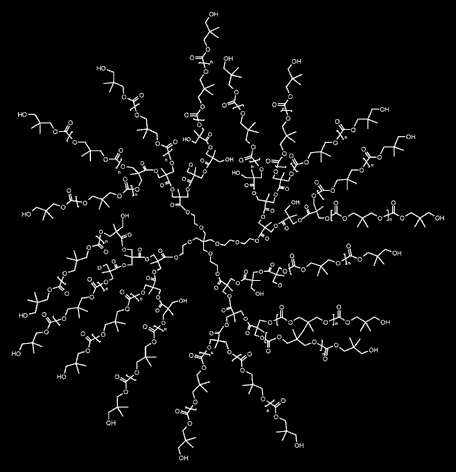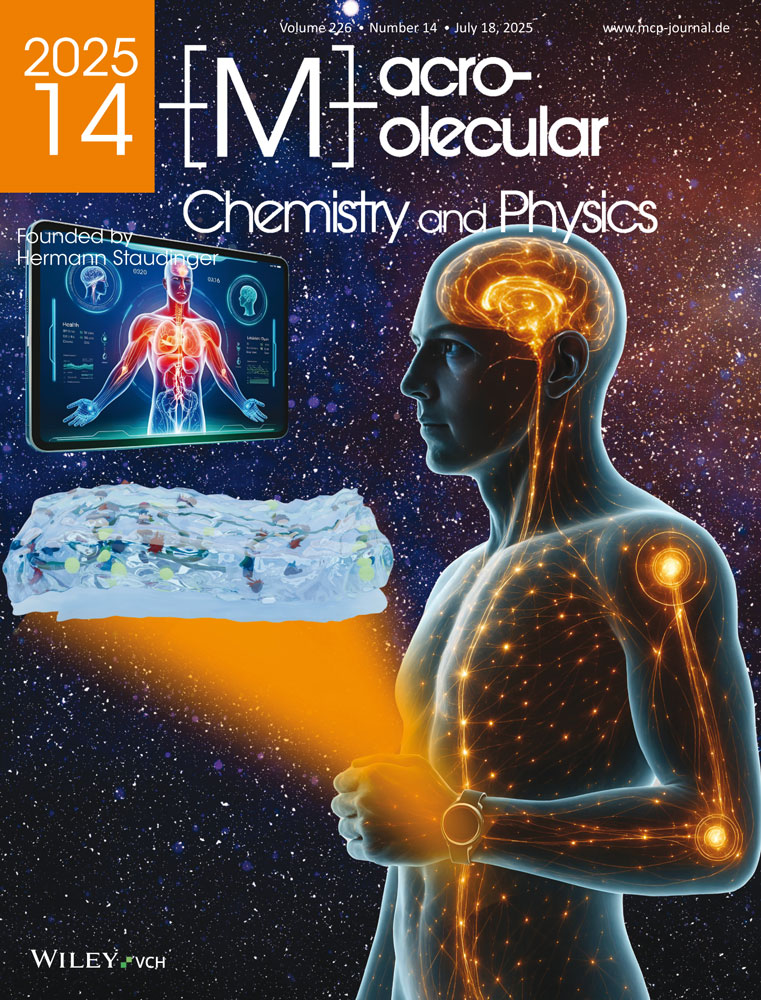Poly(neopentylene carbonate) Hyperstars
Peter Löwenhielm
Fibre and Polymer Technology, Royal Institute of Technology (KTH), Teknikringen 56–58 SE-100 44 Stockholm, Sweden
Search for more papers by this authorHans Claesson
Fibre and Polymer Technology, Royal Institute of Technology (KTH), Teknikringen 56–58 SE-100 44 Stockholm, Sweden
Search for more papers by this authorCorresponding Author
Anders Hult
Fibre and Polymer Technology, Royal Institute of Technology (KTH), Teknikringen 56–58 SE-100 44 Stockholm, Sweden
Fibre and Polymer Technology, Royal Institute of Technology (KTH), Teknikringen 56–58 SE-100 44 Stockholm, Sweden. Fax: (+46) 87908934Search for more papers by this authorPeter Löwenhielm
Fibre and Polymer Technology, Royal Institute of Technology (KTH), Teknikringen 56–58 SE-100 44 Stockholm, Sweden
Search for more papers by this authorHans Claesson
Fibre and Polymer Technology, Royal Institute of Technology (KTH), Teknikringen 56–58 SE-100 44 Stockholm, Sweden
Search for more papers by this authorCorresponding Author
Anders Hult
Fibre and Polymer Technology, Royal Institute of Technology (KTH), Teknikringen 56–58 SE-100 44 Stockholm, Sweden
Fibre and Polymer Technology, Royal Institute of Technology (KTH), Teknikringen 56–58 SE-100 44 Stockholm, Sweden. Fax: (+46) 87908934Search for more papers by this authorAbstract
Summary: Branched aliphatic polycarbonates were synthesized by ring opening polymerization of 5,5-dimethyl-1,3-dioxane-2-one (NPC) initiated from polyfunctional alcohols and a commercial hyperbranched polyester (BOLTORN®). Polymerizations in the presence of fumaric acid under bulk conditions allowed high conversion (80%) without gelation. The synthesis of polymers with long chain branches was confirmed by size exclusion chromatography and universal calibration. The Mark–Houwink exponent decreased, indicating an increased density, while increasing the number of arms. The star polymers with up to four arms showed thermal properties Tg (20–30 °C) and Tm (100–110 °C) similar to linear PNPC.
References
- 1
D. A. Tomalia,
J. M. J. Frechet,
“ Dendrimers and Other Dendritic Polymers”,
Wiley,
New York
2001, p.
1–40.
10.1002/0470845821.ch1 Google Scholar
- 2 T. A. Misev, “ Powder Coatings, Chemistry and Technology”, Wiley, New York 1991, p. 1–8.
- 3 Z. W. Wicks, F. N. Jones, S. P. Pappas, “ Organic Coatings: Science and Technology vol. II”, 2nd edition, Wiley, New York 1999.
- 4 EP 0947254 (1999), Morton International Inc. USA, invs.: E. Reinheimer, A. Daly, R. Haley, G. Mill; Chem. Abstr. 1999, 131, 259000.
- 5 H. Claesson, E. Malmström, M. Johansson, A. Hult, Polymer 2002, 43, 3511.
- 6 H. Claesson, E. Malmström, M. Johansson, A. Hult, M. Doyle, J.-A. E. Månson, Prog. Org. Coat. 2002, 44, 63.
- 7 M. Johansson, E. Malmström, A. Jansson, A. Hult, J. Coat. Tech. 2000, 72.
- 8
M. Trollsås,
C. J. Hawker,
J. F. Remenar,
J. L. Hedrick,
M. Johansson,
H. Ihre,
A. Hult,
J. Polym. Sci. Part A: Polym. Chem.
1998,
36,
2793.
10.1002/(SICI)1099-0518(19981115)36:15<2793::AID-POLA16>3.0.CO;2-M CAS Web of Science® Google Scholar
- 9 H. Keul, H. Höcker, Macromol. Rapid Commun. 2000, 21, 869.
- 10 H. R. Kricheldorf, J. Jenssen, J. Macromol. Sci. Chem. 1989, A26, 631.
- 11 Y. Shibasaki, F. Sanda, T. Endo, Macromolecules 2000, 33, 3630.
- 12 K. J. Zhu, R. W. Hendren, K. Jensen, C. G. Pitt, Macromolecules 1991, 24, 1736.
- 13 EP 837084 (1998), United States Surgical Corp., USA, invs.: S. L. Bennett, K. Connolly, E. Gruskin, Y. Jiang; Chem. Abstr. 1998, 128, 299592.
- 14 S. Sarel, L. A. Pohoryles, J. Am. Chem. Soc. 1958, 80, 4596.
- 15 Jpn. 08134060 (1996), Daicel Chem. Japan, invs.: T. Tabuchi, T. Fujii; Chem. Abstr. 1996, 125, 167997.
- 16 Ger. Offen. 3838752 (1990), Bayer A.-G. Germany, invs.: N. Schoen, H. J. Buysch; Chem. Abstr. 1990, 113, 232237.
- 17 Ger. Offen. 3418091 (1985), Bayer A.-G. Germany, invs.: W. Richter, P. Mues, H. J. Buysch; Chem. Abstr. 1985, 104, 149679.
- 18 E. Zagar, M. Zigon, Macromolecules 2002, 35, 9913.
- 19 L. Garamszegi, T. Q. Nguyen, C. J. G. Plummer, J.-A. E. Månson, J. Liq. Chromatogr. Relat. Technol. 2003, 26, 207.
- 20 B. Pettersson, “ Properties and Applications of Dendritic Polymers”, Perstorp Specialty Chemicals 2001.
- 21 H. R. Kricheldorf, B. Weegen-Schulz, J. Jenssen, Makromol. Chem. Macromol. Symp. 1992, 60, 119.
- 22 H. R. Kricheldorf, R. Dunsing, A. Serra i Albet, Makromol. Chem. 1987, 188, 2453.
- 23 S. Nakano, Prog. Org. Coat. 1999, 35, 141.
- 24 F. Sanda, H. Sanada, Y. Shibasaki, T. Endo, Macromolecules 2002, 35, 680.
- 25 M. Johansson, E. Malmström, A. Hult, Trends Polym. Sci. 1996, 398.
- 26 Z. Gallot-Grubisic, P. Rempp, H. Benoit, J. Polym. Sci. Polym. Lett. Ed. 1967, 5, 753.
- 27 M. Stogiou, C. Kapetanaki, H. Iatrou, Int. J. Polym. Anal. Charact. Sci. 2002, 7, 273.
- 28 A. M. Striegel, R. D. Plattner, J. L. Willet, Anal. Chem. 1999, 71, 978.
- 29
C. A. P. Joziasse,
H. Grablowitz,
A. J. Pennings,
Macromol. Chem. Phys.
2000,
201,
107.
10.1002/(SICI)1521-3935(20000101)201:1<107::AID-MACP107>3.0.CO;2-W CAS Web of Science® Google Scholar
- 30 W. W. Yau, D. Gillespie, Polymer 2001, 42, 8947.
- 31 A. T. Slark, D. C. Sherrington, A. Titterton, J. Mater. Chem. 2003, 13, 2711.
- 32 E. Nunez, C. Ferrando, E. Malmström, H. Claesson, U. Gedde, J. Macromol. Sci. Phys., submitted.
- 33 G. Sidoti, S. Capelli, S. V. Meille, G. C. Alfonso, Polymer 1997, 39, 165.
- 34 W. A. Lee, G. J. Knight, Br. Polym. J. 1970, 2, 73.





